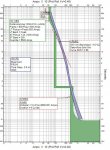sinforoso
Member
- Location
- Columbia, Missouri, USA
Hello everyone,
My apologies if this question appears indicative of incompetence on my part, but for some reason I cannot wrap my head around the relevant code sections involving transformer & conductor OCPD--or the appropriate sequence of steps one must take, if any--despite having scoured the NEC and the Internet to try to dig up as much information on this as possible. So, here's my problem:
I have a 300KVA, 480V delta primary/208V wye secondary transformer, and I want to make sure that everything's installed and adequately protected per Code (as does everyone ). This installation is for a data center renovation, so I'm assuming load continuity for worst-case scenario/nonlinear loads. Below is a rough quasi-flowchart of the current design (using copper conductors):
). This installation is for a data center renovation, so I'm assuming load continuity for worst-case scenario/nonlinear loads. Below is a rough quasi-flowchart of the current design (using copper conductors):
500A brkr -> (2) parallel runs of (3)250MCM & (1)#1G -> 300KVA xfmr -> 1,200A fused disconnect -> (4) parallel runs of (4)400MCM & (1)#3/0G -> 1,200A MCB 208Y/120V panelboard
(bolded text represents "equipment," normal text represents conductors)
Reasoning for the above design:
Anyway, I figured I'd check with you Code wizards out there and get some feedback on this . My apologies for the wall of text.
. My apologies for the wall of text.
Thanks.
My apologies if this question appears indicative of incompetence on my part, but for some reason I cannot wrap my head around the relevant code sections involving transformer & conductor OCPD--or the appropriate sequence of steps one must take, if any--despite having scoured the NEC and the Internet to try to dig up as much information on this as possible. So, here's my problem:
I have a 300KVA, 480V delta primary/208V wye secondary transformer, and I want to make sure that everything's installed and adequately protected per Code (as does everyone
500A brkr -> (2) parallel runs of (3)250MCM & (1)#1G -> 300KVA xfmr -> 1,200A fused disconnect -> (4) parallel runs of (4)400MCM & (1)#3/0G -> 1,200A MCB 208Y/120V panelboard
(bolded text represents "equipment," normal text represents conductors)
Reasoning for the above design:
- Xfmr Primary:
- 300KVA @ 480V = 361A, therefore OCPD should be at least 125% of that, therefore 361A becomes 451A, therefore next size up is 500A.
- Only 3 CCCs, therefore no derating, therefore (2) runs of 250MCM per the 75o table gives 255A * 2 = 510A = sufficient conductor ampacity to withstand maximum possible current going through breaker.
- Xfmr Secondary:
- 300KVA @ 208V = 833A, but because of harmonics and assumed continuous load, I assumed 125% of that, therefore 833A becomes 1041A, therefore--though the "next size up" rule does not apply to xfmr secondaries or to loads > 800A--the only "logical" choice for conductor OCPD from the way I'm interpreting the Code is a 1200A fused disconnect.
- 4 CCCs, therefore conductor ampacity must be derated to 80% (from the 90o table), therefore (4) runs of 400MCM * 0.8 = 380A * 4 * 0.8 = 1,216A = sufficient conductor ampacity to withstand maximum possible current going through disconnect = sufficient conductor ampacity to feed 1200A MCB panelboard downstream.
Anyway, I figured I'd check with you Code wizards out there and get some feedback on this
Thanks.

